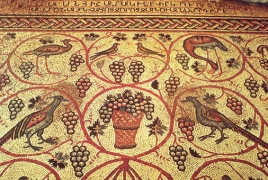 Armenian culture treasures in JerusalemPriceless collections Armenian culture has been preserved through millennia. Nowadays, various artifacts are kept at museums across the globe, being pearls of different collections. PanARMENIAN.Net - PanARMENIAN.Net continues to present Armenian cultural heritage showcased at museums all over the world. Now it’s the time for Jerusalem, a city which has been a center of Armenian culture since the Middle Age. Gold and silver items made by Armenian masters, churchware, candelabra, crosiers and manuscripts have been attracting pilgrims of all times. The Edward and Helen Mardigian Museum of Armenian Art and History of Jerusalem was founded in 1979 in a building that was constructed in 1855 and once housed the Armenian Patriarchate’s Theological Seminary. After the seminary was moved into a new building, it was decided to turn the original premises into a museum, which consists of three exhibition halls: The first showcases the old collection of the Patriarchate and Churches, as well as china and kitchen utensils of the Armenian priests. The second chronicles the development of Armenian art in Jerusalem and holds numerous masterpieces by local Armenian masters, Armenian pilgrims’ maps, globes, manuscripts and even munitions and weapons presented to the Crusaders. The most interesting object, however, is the first printing machine of the Middle East and the first photos of Jerusalem taken by Patriarch Yesayi in 1853. These pictures depict everyday life of the Holy City in 19th century. The third room is dedicated to the Armenian Genocide. During the First World War, the seminary was was used as an orphanage for children who escaped the Genocide. Later that facility was moved to new quarters. The first printing machine of the Middle East The Armenian Patriarchate of Jerusalem is a major religious, educational, cultural, and ecumenical institution, established more than fourteen centuries ago. The Calouste Gulbenkian Library is one of the Patriarchate’s intellectual resource centers. Plans for its establishment began in 1925 as a tribute to Patriarch Yeghishe ITourian to commemorate the 50th anniversary of his ordination to the priesthood. Its primary mission has been to collect and preserve valuable works of Armenian religion, language, art, literature, and history, as well as representative works of world literature in a number of languages. Calouste Gulbenkian (March 1869 – July 1955) was a British businessman and philanthropist of Armenian origin. Throughout his life, Gulbenkian was involved with many philanthropic activities including the establishment of schools, hospitals, and churches. The Calouste Gulbenkian Foundation, a private foundation based in Portugal, was started at his bequest in 1956 and continues to promote arts, charity, education, and science throughout the world. The Library was set as a centralized point of access to the Patriarchate’s repositories of books, artifacts, and archives, and to serve the information needs and intellectual pursuits of the religious and lay populations of Armenian Jerusalem and the Armenian Diaspora. Through its history, the Gulbenkian Library emergesas the gateway to information for the Armenian Patriarchate, brought to fruition due to the collective resolve of its parent institution and its leadership. Among the other treasures of Armenian culture, the Library holds the Gospel of Queen Keran, which was commissioned by the Queen at Sis, Cilicia, in 1272 after the ascension of her husband, Leo II to the throne. The Queen is represented in one of the last leaves, together with her husband, King Leo and their three children – kneeling piously in front of a “Deisis”. The Esubesian letter, the Canon table, and the dedication pages are all executed in the traditional Armeno-Byzantine style. Samson Hovhannisyan / PanARMENIAN.Net The Oscar-winning helmer who hopes to return to Armenia many, many times ICAE2018 proves a success Telling a story in a single image Chance to have another dream The other side of music How Indians turned into Armenian Gypsies Armenian Renaissance |